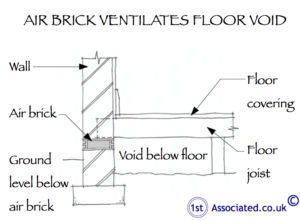French Drains
1stAssociated.com can provide advice and help with regard to Building Surveys (also known as Structural Surveys). We also carry out Schedules of Condition, Property Reports, Specific Defects Reports (also known as Damp Reports or Engineers Reports).
We have written many other articles that may be of interest to you - please see the links below.
If you have a property problem or would like a survey report carried out please Freephone us on 0800 298 5424 and a surveyor will call you back.
Free phone 0800 298 5424
Using a French Drain to resolve a Damp Problem

We are finding where we are asked to look at damp walls and damp floors or damp problems in general that commonly it is because the external ground level is higher than the internal ground level, or airbricks have been blocked, or simply paving slabs, decking or briquettes have been used to form a patio area. This then discharges any rainwater against the building.
Quite often the solution is to add a French drain.
|
|
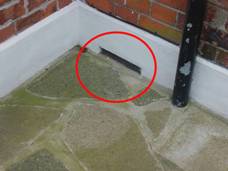 |
|
Airbrick acting as gutter |
High paving slab - Airbricks acting as gutters |
What is a French Drain?
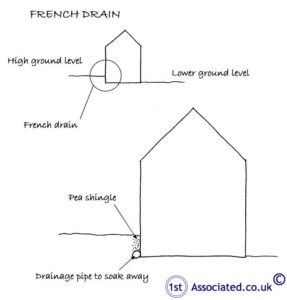
French drains are quite simple and are basically nothing more than trenches filled with gravel, although there is a bit more to them as we will explain. They are almost a D.I.Y. job for most people and they are relatively easy to install and are low cost.
However, you do need some care and attention, otherwise you can install what we have heard referred to, as the French pond.
What use is a French Drain?
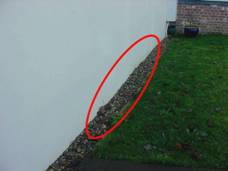
A French drain is a trench, the width of approximately six inches or 300 millimetres wide, or the width of your spade, and is approximately twice the depth, i.e. 12 inches or 300 millimetres. In most cases this will suffice, however, where there is a great deal of ground water you may wish to make the trench wider and deeper.
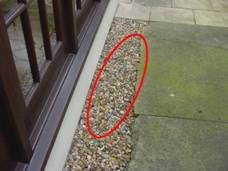
The French drain acts as an area where water soaks away quickly. We often recommend them close to the building, but not next to the building, as this helps reduce the ground level and/or take away any water that is directed at that area, for example, where a patio has been put in place which aims any rainwater at part of the wall.
As mentioned, whilst a French drain is a D.I.Y. job, you do need some understanding of how it works.
French Drains must be on a slope
The piping that goes at the base of a French drain should be perforated or, as we did years ago for land drains, there should be gaps between each pipe. It should be set onto a bed of firm ground and the pipes should have a fall to the drain. Whilst you should be able to ensure there is enough fall by sight, we also like the idea of rolling a marble from one end to the other.
You will then need to put the pipes down and fill the trench with half an inch to an inch of good sized gravel. You can leave it at that, or in addition you can cover with sand and then turf over. This is how a basic French drain is carried out.
The French Drain System which we would recommend
This would be as described, although we would add to the base an inch or two of gravel onto which the perforated drainage pipe will rest. It will then wrap around that drainage pipe filter fabric. This is to stop the holes in the perforated pipe from blocking up. By the way, the drainage pipe should be four to six inches/100 millimetres to 250 millimetres. We would then fill with gravel.
In addition to this, we would add a silt trap and this is added in the run of the pipe and is very similar to a road gully (not that it is of much use if you don't understand how a road gully works). The silt trap is a rectangular box with a pipe opening at each end. The drained water passes onto this and any particles sink to the bottom of the box and then the water travels on to the other side of the box, enabling you to feed into a drain.
These are usually made of glass reinforced polyester and have been available in this form since the mid 1980's. They are normally reinforced with a steel frame for additional strength and re-bedded in concrete.
The French Pond!
French drains will over time clog up, which is why we recommend using a filter fabric however even with this, they will eventually clog up. Unfortunately there is no Dyno Rod equivalent and it is normally fine sand organic matter or clay which clogs up the French drain. In this case it will have to be dug up and the pipe work will require cleaning (or it may be quicker to just replace it) adding a filter fabric and refilling the gravel.
You may also be interested in these other articles about dampness issues:
Condensation
Resolving Dampness in your Basement
Dampness in Buildings - Basics Article
Dampness in Buildings - Technical Article
Dampness Defects Report
Dampness Problems
Condensation Problems
Damp Walls
Shared Freehold and Problems with Damp
Damp proof courses defined
Damp Proof Courses - What are these for?
Damp Proof Specialists - Talk to us First
How do Older Properties keep dry without a damp proof course?
Rising Damp and Independent Reports
Please see our section on:
Specific Defects Reports
Caveat Emptor
Caveat emptor means buyer beware and is why you need to have a building survey, often known as a structural survey, to find out if there are any problems within the property. This is very important as the estate agent is unlikely to advise you of any.
What do the red ovals / circles mean?
The red ovals are a system that we used within our structural surveys and building surveys to highlight problem areas so that you are not left wondering what the problem is. In addition to this, if the photographs do not we believe explain the problem enough together with our survey report we also add in one of our own sketches such as the example that is shown here.
The good, bad and ugly survey
We would also like to introduce to you what we call our good, bad and ugly survey which is a building survey which is sometimes known as a structural survey which we have developed over many years, in fact several decades. We have listened to feedback from our clients and amended and altered our surveys to make them easy to read and describe issues clearly. The key factor we believe is our surveys are easy to understand in plain English but do not take our word for it call us on free phone 0800 298 5424 and ask a surveyor for an example of one of our surveys to be emailed to you.
We have normally carried out a building survey similar to the property you are considering buying and therefore we can show you an example of the type of structural survey you will be receiving. We would recommend that you do not just book a survey but with whoever you decide to have your independent building survey with you talk to them, receive an example survey as well as meet with the surveyor at the property.
There are various ideas we have developed over the years to make our surveys more readable everything from 16x optical zoom digital photographs next to the problem which show and explain what the problem is to sketches that clarify any issues particular ones that we cannot photograph but know are present. We have commissioned our own sketches to explain property issues which you will not find with any other Surveyor.
Independent Surveyors
If you are experiencing dampness in your property and truly do want an independent expert opinion from a building surveyor, we are able to do specific defects reports relating to the particular problem, building surveys, structural surveys, structural reports, engineers reports, valuations, home buyers reports or any other property matters. Please contact us on 0800 298 5424 to have a free of charge friendly chat.
We feel our surveys are quite unique, as they are written to your level of knowledge. As you can see from this article our surveys include photos and sketches. The survey will also include an action required section and an estimate of costs in the executive summary. We are more than happy to meet you at the property whilst carrying out the survey to discuss any specific issues.
Commercial Property
If you are looking for commercial property, whether it is freehold or leasehold, we would recommend a survey as this will prevent dilapidations claims in the long run. You may wish to look at our Dilapidations Website at www.DilapsHelp.com and for Disputes go to our Disputes Help site www.DisputesHelp.com, both of which we have been advised are very helpful!
We hope you found the article of use and if you have any experiences that you feel should be added to this article that would benefit others, or you feel that some of the information that we have put is wrong then please do not hesitate to contact us (we are only human).
The contents of the website are for general information only and is not intended to be relied upon for specific or general decisions. Appropriate independent professional advice should be paid for before making such a decision.
All rights reserved by 1stAssociated.co.uk
All rights are reserved the contents of the website are not to be reproduced or transmitted in any form in whole or part without the express written permission of www.1stAssociated.co.uk.


